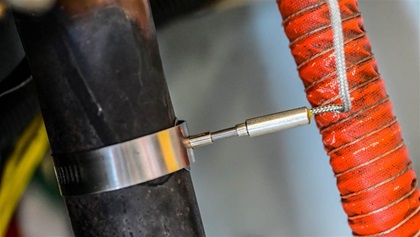Data overload
Making sense of what your engine monitor is telling you

Photography by David Tulis
The first “problem” cropped up almost immediately. Problem in quotes because I couldn’t be sure there was a problem. The cylinder head temperature line looked like an ocean wave, the exhaust gas temperature not much different, and the difference between each cylinder’s temperature like the gap between a Minnesota winter and Florida summer. As I stared at the data, I couldn’t help but wonder what normal looks like. The answer is surprisingly hard to come by.
After hours of sleuthing and multiple phone calls to the manufacturer of our device, the only thing I was sure of was that while companies are good at manufacturing these devices, that’s where their work ends. What you do with the data and how to interpret it is effectively ignored.
As one of the foremost advocates of modern engine monitors, and with a company that supports the analysis of the data, Mike Busch, CEO and creator of Savvy Aviation, seemed the logical choice to contact. SavvyAnalysis, the company’s free data upload and analysis tool, seems like a fantastic gift to the community—and it is—but Savvy also benefits greatly from receiving more aggregate data for analysis. The free version of the tool allows users to easily read the data and parse it in numerous ways, but it leaves interpretation solely up to the owner and his mechanic. There’s a paid version that offers quite a bit more (more on that later).
Busch hinted that I was probably expecting too much. “Engine monitors are good for essentially three functions,” he said. They are direct engine instrumentation that leads to more effective engine management; real-time alarms; and data analysis.

Using an engine monitor for the first capability is straightforward and well understood. Busch and others have written extensively on managing the engine using an engine monitor. Things such as leaning in the climb, leaning using CHT instead of EGT, and operating lean of peak are all well established and proven techniques that while possible without a monitor, are certainly safer for the wallet and easier with one. I say well understood because General Aviation Modifications Inc., Busch, and others have spent an enormous amount of time and energy trying to educate us on the benefits of keeping cylinder head temperatures cool, what’s actually happening when you run lean of peak, and why EGT isn’t the best tool for leaning. But how well most owners understand this is less clear. To be fair, it can take a long time to correct decades of misinformation or misunderstanding that occurred prior to the proliferation of engine monitors.
What good is it to have the data and be able to download it if we can’t tell what’s normal and what’s not?In terms of real-time warnings, Busch said he is frustrated that we seem to be trending in the wrong direction and manufacturers are making it harder for pilots to program their own alarms. “When we’re flying, we’re largely looking at the flight instruments and looking out the windshield, so you really need an alarm system,” he said. And it should be programmable to your liking. Seeing a CHT alarm at 500 degrees Fahrenheit, for example, is too little, too late. It’s better to see it at 400 or 420 degrees when something can be done about it. Busch also hopes that someday the engine monitor manufacturers will provide even more sophisticated alarms that track multiple data points. A high CHT may be a problem, or it could be a sensor. But when you cross-reference it with EGT you have a much more powerful tool.
Using a monitor to diagnose problems is less well understood and was the root of my consternation. Savvy Aviation recommends a test profile that includes an in-flight magneto test, mixture sweeps, and an induction leak test. From there one can determine the health of the ignition system, measure fuel injection performance, find induction leaks, and more. Most technicians still don’t know how to interpret the data, however, so it’s up to you to find the meaning of the results and essentially do the technician’s troubleshooting work for him. Unlike auto manufacturers that make it easy for a technician to read a diagnostic code and immediately know what’s wrong with a car, at this point our engine monitors can only back up a pilot who says, “It’s running rough,” with rudimentary data of fuel flow and temperature. What to do with that information is only recently beginning to become more common knowledge.

Which all leads to analysis. Despite monitors being commonplace in the general aviation fleet for a few decades now, we know very little about what a standard profile should look like for each airplane and engine. We know redlines. It’s easy to look at the data and say the engine oil was in the green or the CHTs didn’t exceed 400 degrees, but that’s Little League stuff. What good is it to have the data and be able to download it if we can’t tell what’s normal and what’s not?
Years ago Busch noticed that prior to an exhaust valve failure there was a regular EGT oscillation of about one cycle a minute. With some further sleuthing he realized that was the rate at which the valve rotates, so the temperature swing was the valve moving from the hot side to the cold side. In 2011 Savvy Aviation released a tool that finds that signature in a customer’s data and alerts him to the potential for a valve problem. I couldn’t help but notice our EGT line oscillated, but zooming in on the platform it’s a much smaller temperature swing and a much more rapid change. Normal, I think.
I never worried about my exact EGT prior to installing the engine monitor, and our engine never had any serious problems. We were the proverbial fat, dumb, and happy.Busch is hoping for more progress in the future. Savvy is in the midst of Project GADfly, or generalized anomaly detection. The concept is simple. Take a somewhat homogenous fleet (thank you, Cirrus) and gather all its data. Map the complete data set over a period of thousands of flights to establish what Busch calls a hyperblob. Then build a profile of nearly every parameter around that tightly clustered data set, and eventually create analysis tools that alert owners when one of their data points is outside the blob.
In one sense, Project GADfly is the answer to my questions. I’ll finally be able to know whether the 430-degree Fahrenheit gap in EGT at lower power settings was really outside the norm or common behavior for an IO-360-KB. But I can’t help but wonder if it really matters. I never worried about my exact EGT prior to installing the engine monitor, and our engine never had any serious problems. We were the proverbial fat, dumb, and happy. But someone had looked at our data, noted the large gap as a potential problem, and we started looking for the culprit. A bad injector was suspected. The mechanic measured the output from each of the injectors and found them to be perfect. We asked Continental, told them about the stumble and sharp drop-off of the fuel flow from cylinder two soon after takeoff on one flight, and followed their troubleshooting steps. Without a clear answer they sent us a new fuel spider under warranty. We excitedly fitted it, went flying, and got the exact same results. Today we ignore the data and assume it to be normal, but that’s only because otherwise we’d never fly, and there haven’t been any more engine stumbles.

It’s a dilemma we all face every day as we balance the gift of information with the burden of knowledge. How much weight to give the data is personal preference, but between the extremes of hardline head-in-the-sanders and data geeks sweating a one-degree difference between cylinders four and five are most of us who are easily driven down a rabbit hole by the desire to have our airplanes be safer and more reliable.
 How to avoid becoming neurotic and calm our uncertainties in the meantime? I asked Busch what I could focus on and what I could ignore, and while he didn’t seem too interested in what could be completely ignored, he did offer a few things to focus on, one which surprised me. Once in flight, he said, oil pressure should be rock solid. The oil pump cycles significantly more oil than the engine needs, and the oil pressure relief valve regulates the pressure precisely. Busch described it as one of the few engine parameters that’s regulated. Oil temperature is another through the Vernatherm. “They should be very stable, and anything that causes oil pressure to fluctuate is bad.” So, if pressure is going up or down in flight, it’s a near certainty there is a problem. Sometimes a serious one that requires quick action.
How to avoid becoming neurotic and calm our uncertainties in the meantime? I asked Busch what I could focus on and what I could ignore, and while he didn’t seem too interested in what could be completely ignored, he did offer a few things to focus on, one which surprised me. Once in flight, he said, oil pressure should be rock solid. The oil pump cycles significantly more oil than the engine needs, and the oil pressure relief valve regulates the pressure precisely. Busch described it as one of the few engine parameters that’s regulated. Oil temperature is another through the Vernatherm. “They should be very stable, and anything that causes oil pressure to fluctuate is bad.” So, if pressure is going up or down in flight, it’s a near certainty there is a problem. Sometimes a serious one that requires quick action.
Other than that, using the monitor to ensure CHTs stay below 400 degrees Fahrenheit on a Continental and 420 degrees F on a Lycoming will help extend the life of the engine and cylinders immensely.
If that doesn’t help ease your engine monitor anxieties, Savvy Aviation also has a report card for owners who fly most common light airplanes. The report card is 12 parameters that provides trend data for your engine, and some indexing to others like yours in the fleet. Savvy knows, for example, that the temperature gap between the cylinders in our IO-360-KB CHTs is completely normal.
It’s a good start toward a promising future that will take our engine monitors from mere sophisticated management devices to the foundation of hard-core diagnostic information. Count me in.



